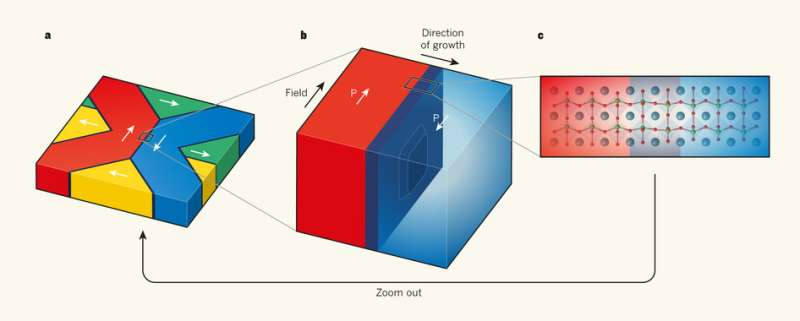June 16, 2016 report
Model that can give accurate descriptions of behavior in ferroelectric materials developed

(Phys.org)—A team of researchers with the Carnegie Institution for Science and the University of Pennsylvania has developed a model that allows for accurately predicting how ferroelectric materials will behave when exposed to an electric field. In their paper published in the journal Nature, the team describes how they used one factor all such materials had in common to create the model and how it might be used in future applications. Patrycja Paruch with the University of Geneva and Philippe Ghosez with the University of Liège offer a News & Views paper on the work done by the team in the same issue, and why they believe the model could be used to design new types of sensors.
Ferroelectric materials are those that exhibit spontaneous electric polarization when exposed to an electric field. They are used in a wide variety of applications such as tunable capacitors. Over time, scientists have discovered that it is possible to make a single material that has different parts of it that polarize in different directions when the electric field is applied. These parts are known as regions and they are separated from one another by what are known as domain walls. Polarization can occur for any one domain when it is aligned with the direction of the electric field, thus only those that polarize in the same direction as the electric field polarize when the field is applied—when this occurs the domain is caused to grow in size, taking over some of the area occupied by other regions by causing new region growth or by bending the walls of the border that separates them. It is this second action that was at the heart of the research done by the group with this new effort, because domain wall motion is integral to the functioning of a finished product when making something that relies on ferroelectric materials—but up till now, engineers had no way of predicting how those walls would behave under different conditions with different materials.
To create a model able to make such predictions, the researchers relied on the fact that all ferroelectric materials have one trait in common: the potential energy across planes of crystal lattices serve as a periodic pinning potential that controls the motion of domain walls. Using this one factor allowed the researchers to create a model able to predict domain wall action across a wide range of ferroelectric materials, which should help reduce development time, and even perhaps lead to new types of devices based on ferroelectric materials.
More information: Shi Liu et al. Intrinsic ferroelectric switching from first principles, Nature (2016). DOI: 10.1038/nature18286
Abstract
The existence of domain walls, which separate regions of different polarization, can influence the dielectric, piezoelectric, pyroelectric and electronic properties of ferroelectric materials. In particular, domain-wall motion is crucial for polarization switching, which is characterized by the hysteresis loop that is a signature feature of ferroelectric materials. Experimentally, the observed dynamics of polarization switching and domain-wall motion are usually explained as the behaviour of an elastic interface pinned by a random potential that is generated by defects, which appear to be strongly sample-dependent and affected by various elastic, microstructural and other extrinsic effects. Theoretically, connecting the zero-kelvin, first-principles-based, microscopic quantities of a sample with finite-temperature, macroscopic properties such as the coercive field is critical for material design and device performance; and the lack of such a connection has prevented the use of techniques based on ab initio calculations for high-throughput computational materials discovery. Here we use molecular dynamics simulations of 90° domain walls (separating domains with orthogonal polarization directions) in the ferroelectric material PbTiO3 to provide microscopic insights that enable the construction of a simple, universal, nucleation-and-growth-based analytical model that quantifies the dynamics of many types of domain walls in various ferroelectrics. We then predict the temperature and frequency dependence of hysteresis loops and coercive fields at finite temperatures from first principles. We find that, even in the absence of defects, the intrinsic temperature and field dependence of the domain-wall velocity can be described with a nonlinear creep-like region and a depinning-like region. Our model enables quantitative estimation of coercive fields, which agree well with experimental results for ceramics and thin films. This agreement between model and experiment suggests that, despite the complexity of ferroelectric materials, typical ferroelectric switching is largely governed by a simple, universal mechanism of intrinsic domain-wall motion, providing an efficient framework for predicting and optimizing the properties of ferroelectric materials.
Journal information: Nature
© 2016 Tech Xplore


















